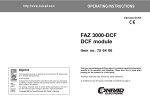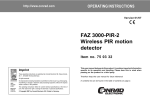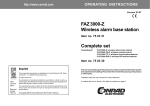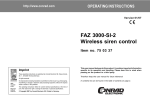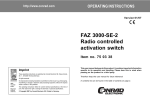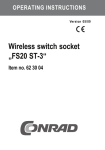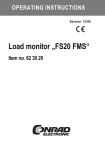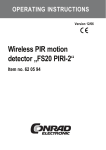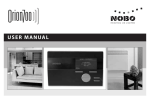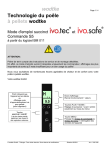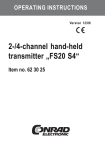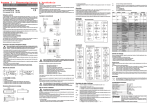Download FAZ3000-FB-2 Wireless remote control
Transcript
OPERATING INSTRUCTIONS Version 01/07 FAZ3000-FB-2 Wireless remote control Item no. 75 08 43 This user manual belongs to this product. It contains important information specific to its operation and handling. Please bear this in mind when passing on the product to a third party. Therefore keep this user manual for future reference! A contents list can be found in the table of contents on page 3. Introduction Dear customer, Thank you for purchasing this product. This product meets the requirements of both current national and European guidelines. In order to ensure continued fulfilment of legal requirements and safe operation of this product, we kindly ask you to carefully follow the instructions in this user manual! Please read the user manual completely and observe the safety and operation instructions before using the product! All company and product names contained herein are trademarks of their respective owners. All rights reserved. Should you have any further questions, please contact our technical service: Germany: 2 Tel. no.: +49 9604 / 40 88 80 Fax. no.: +49 9604 / 40 88 48 Email: [email protected] Mon. to Thur. 8.00am to 4.30pm Fri. 8.00am to 2.00pm Table of contents Page 1. Prescribed use ...................................................................................... 4 2. Scope of delivery ................................................................................. 4 3. Explanation of icons ............................................................................. 4 4. Safety instructions ............................................................................... 5 a) General information ........................................................................ 5 b) Handling the batteries ..................................................................... 6 5. General information .............................................................................. 7 6. Controls ................................................................................................ 8 a) Normal button functions ................................................................ 8 b) Special function ‘attack alarm’ ...................................................... 9 7. Inserting the batteries, entering the security code ........................... 10 8. Registering the remote control to the ‘FAZ-Z’ alarm base station ... 12 9. Deleting a remote control from the ‘FAZ-Z’ alarm bas station ........ 14 10. Information on the range ................................................................... 16 11. Handling .............................................................................................. 17 12. Maintenance and cleaning .................................................................. 18 13. Disposal .............................................................................................. 19 a) General information ...................................................................... 19 b) Battery/rechargeable battery disposal ........................................ 19 14. Technical specifications ..................................................................... 20 15. Brief instructions ................................................................................ 21 a) Registering the remote control in the alarm base station ........... 21 b) Replacing the batteries of the remote control ............................ 21 c) Deleting a remote control from the alarm base station .............. 21 16. Declaration of conformity (DOC) ...................................................... 22 3 1. Prescribed use The ‘FAZ3000-FB-2’ wireless remote control is a part of the ‘FAZ3000’ wireless alarm system. The ‘FAZ3000-FB-2’ wireless remote control is used to activate/deactivate the ‘FAZ-Z’ alarm base station (toggle between ‘disarmed’, ‘internally armed’ and ‘externally armed’). It also has a panic function that can trigger an alarm using the ‘FAZ-Z’ alarm base station. Any use other than the one described above may damage the ‘FAZ3000-FB2’ wireless remote control. No part of the product may be modified or adapted. Take note of all the safety instructions in this user manual. 2. Scope of delivery • Wireless remote control • User manual 3. Explanation of icons An exclamation mark in a triangle in this user manual points to important instructions that must be observed without fail. 4 The ‘hand’ symbol indicates special tips and information on operation. 4. Safety instructions The product’s guarantee becomes invalid, if the product is damaged as a result of the failure to observe these operating instructions! We do not assume any liability for any resulting damages! We do not assume liability for damage to property or personal injury caused by improper use or failure to observe the safety instructions. In such cases the product’s guarantee becomes invalid. Dear customer, the following safety instructions are intended to protect you as well as the device. Please take time to read through the following points: a) General information • For safety and licensing (CE) reasons any unauthorised alterations to and/ or modification of the product are not permitted. • This product is not a toy and should be kept out of the reach of children. • The remote control must not get damp or wet, otherwise it may be damaged. • Do not leave packaging material lying around. This may become a dangerous plaything in the hands of children. • All maintenance work, programming or repairs should only be carried out by a skilled technician or professional workshop. • Handle the remote control with care; even a fall from a low height can damage it. 5 b) Handling the batteries • Keep batteries out of the reach of children. • Make sure that the polarity is correct when inserting the batteries. • Do not leave batteries lying around as they could be swallowed by children or pets. In such case seek immediate medical care. • Leaking or damaged batteries may cause acid burns, if they come into contact with skin. Therefore, please make sure you use suitable protective gloves. • Make sure that batteries are not short-circuited or thrown into a fire. They might explode! • Never take batteries apart! • Conventional batteries must not be recharged. They might explode! • If the device is not used for a longer period of time (for example, when stored), remove the inserted battery to prevent it from leaking and causing damage. 6 5. General information The ‘FAZ3000-FB-2’ wireless remote control is part of the ‘FAZ3000’ wireless alarm system, and is used to activate/deactivate the ‘FAZ-Z’ alarm base station. The ‘FAZ3000-FB-2’ wireless remote control can be used to toggle the ‘FAZ-Z’ alarm base station between three modes, namely ‘disarmed’, ‘internally armed’ and ‘externally armed’. The remote control also has a built-in panic function. The alarm base station can trigger an alarm when a specific button combination is entered on the remote control. The remote control can be used as an emergency call transmitter for persons at risk (for instance, cashiers, petrol pump attendants, etc.) in order to trigger an alarm irrespective of the location in case of an attack. The remote control has a security code to protect the alarm base station from unauthorised use; this code must be entered after inserting the batteries before the initial operation. The security code comprises a 9-digit button sequence that must be entered using 3 buttons. Thanks to the 39 = 19683 different codes, an extensive protection against unauthorised use is guaranteed, since only the remote control registered to the alarm base station can initiate functions using a specific code. All other codes are ignored. Four remote controls with different security codes can be registered in the alarm base station. However, any number of remote controls can be then operated using one of these four codes. Owing to its compact dimensions, the remote control can be also used as a key chain. Note that buttons may be pressed accidentally near the alarm base station if the remote control is kept in one’s pockets. The alarm base station may be activated or deactivated accidentally and unintentionally! 7 6. Controls 1 ‘ext.’ button (= ‘externally armed’) 2 ‘int.’ button (= ‘internally armed‘) 3 LED 4 ‘unscharf’ button (= ‘disarmed’) 5 Opening to attach to a key ring The cover of the battery compartment is located at the rear side of the remote control. 3 2 4 ext. int. 1 unscharf 5 a) Normal button functions ‘unscharf’ (disarm) button ( 4) • This button is used to ‘disarm’ the alarm base station. All sensors except the smoke detectors are deactivated. You can move around your house freely without setting off the alarm. An alarm is always triggered when a smoke detector or a glass break sensor (terminal KL1, NO contact required) connected to the ‘FAZ-TF’ door/window sensor is triggered. • A triggered alarm can be stopped by pressing the ‘unscharf’ (disarm) button ( ). The alarm memory is deleted when this button is pressed again. 4 ‘int.’ button ( 2) • The ‘internally armed’ mode of the alarm base station is set. This is used to protect the outer shell, for instance, for protection inside a house at night. One can move inside the house freely. Ensure that the sensors are configured accordingly (internal/external sensor). • The activation is rejected when the button is pressed for the first time if there is a fault or a magnetic contact is not closed (for instance, a window is open). The ‘internally armed’ mode is forced to be set when the button is pressed again. 8 ‘ext.’ button ( 1) • You can use the ‘ext.’ button to set the ‘externally armed’ mode of the alarm base station. This function is used to monitor a house when nobody is present in the house; indoor areas are also monitored (for instance, using the ‘FAZ-PIR’ PIR motion detector). • If there is a fault or if a magnetic contact is not closed (for instance, a window is open), the activation is rejected when the button is pressed for the first time. The ‘externally armed’ mode is forced to be set when the button is pressed again. b) Special function ‘attack alarm’ In the case of an attack, the remote control can be used to immediately set off an alarm. This ‘attack alarm’ can be signalled using different components of the ‘FAZ3000’ wireless alarm system, for instance, using an external siren (using the ‘FAZ-SI’ siren control unit). Note that in the ‘FAZ-Z’ alarm base station you can customise the trigger settings in case of an attack (as per the default setting, the attack alarm can be activated only using the internal siren). On the remote control two button combinations are each joined by a dashed line: • Button combination 1: Button ‘ext.’ and button ‘unscharf’ (disarm) • Button combination 2: Button ‘int.’ and button ‘unscharf’ (disarm) Simultaneously pressing one of these button combinations sets off the attack alarm. Please note: An attack alarm is not triggered when all three buttons of the ‘FAZ3000-FB-2’ remote control are pressed simultaneously. Likewise, simultaneously pressing the two ‘ext.’ and ‘int.’ buttons does not set off an attack alarm. You can stop the alarm in the usual way; simply press the ‘unscharf’ (disarm) button briefly on the alarm base station or the remote control. 9 7. Inserting the batteries, entering the security code The security code comprises a 9-digit button sequence that must be entered (at the time of the initial operation) using the 3 buttons after inserting the batteries. The security code of the remote control is stored in the alarm base station so that the remote control can be registered in the ‘FAZ-Z’ alarm base station later. If the ‘FAZ-Z’ alarm base station detects the radio signal of the ‘FAZ3000-FB-2’ remote control, the alarm base station responds only if the received security code matches the stored security code. Proceed as follows: 1. Determine a 9-digit security code and note it down on a piece of paper. The security code may contain only the numbers ‘1’, ‘2’ and ‘4’, for instance, 142142142. The alarm base station can store a maximum of four different security codes. You should note down the security code and store it properly. This is practical when you wish to program another remote control using the same security code at a later date, or when you wish to ensure that you do not reuse the same security code accidentally if the remote control is lost. 2. Open the cover of the battery compartment at the rear side of the remote control, for instance, using a coin. Rotate the cover clockwise (in the arrow direction ‘opent’) slightly until it can be removed. 3. Insert one CR2016 type battery observing the correct polarity (the plus pole ‘+’ of the battery has to point outwards towards you). 4. Replace the cover properly and close it by slightly rotating it anticlockwise (in the arrow direction ‘sclose’). 5. If a security code has been already programmed (if you have simply replaced the battery), the remote control is ready for operation. Proceed 10 as described below (‘Re-entering or changing the security code’) if you wish to enter a new security code. 3 6. At the time of the initial operation, the LED ( ) on the front side blinks for approximately 20 seconds; this indicates that it is ready to accept the security code input. The LED goes out if you do not enter the security code within these 20 seconds. Pressing any button activates the entry mode again for 20 seconds. 7. Enter the 9-digit security code using the three buttons of the remote control (only at the time of the initial operation): 1) : 2) : ‘ext.’ button ( Numerical value: 1 ‘int.’ button ( Numerical value: 2 Numerical value: 4 ‘unscharf’ (disarm) button ( 4) : Example: 142142142 8. The LED goes out after entering the security code; the remote control is ready for operation. The remote control can be now registered to the alarm base station, see section 8 on page 12. Re-entering or changing the security code (for instance, in case of a wrong input or to change the security code): 1. Keep the ‘ext.’ button ( 1) pressed. 2. After about 5-6 seconds, the LED lights up for approximately five seconds and then goes out. Release the button only after that. 3. The LED starts to blink. 4. Proceed from step 7 above to enter the security code. Please note: If the remote control has been already registered to the alarm base station using a particular security code, you must delete this security code from the alarm base station before changing it. The remote control can be registered again to the alarm bas station after entering a new security code. 11 8. Registering the remote control to the ‘FAZ-Z’ alarm base station The remote control must be registered to the alarm base station to ensure that the ‘FAZ-Z’ alarm base station responds to the ‘FAZ3000-FB-2’ remote control. The alarm base station stores the security code of the remote control. As a result, the ‘FAZ-Z’ alarm base station responds to the ‘FAZ3000-FB-2’ remote control only if the received security code matches the security code stored in the alarm base station. Proceed as follows to register: • You must be on the top level. The LCD should appear as on the right, for example, with the time and the date. disarm 16:30 14.12 • Briefly press the ‘Menü a/A’ button on the control unit of the ‘FAZ-Z’ alarm base station. troubles • Use the ‘y’ and ‘z’ buttons to select the sensors ‘sensors sensors’ menu. sensors • Confirm by briefly pressing the ‘OK’ button. sensors add ‘sensors add’ appears, see the figure to the right. sensors add • Press the ‘OK’ button again. Here ‘X’ is the number of sensors that have already been registered plus one (if no sensor has been registered yet, then X=1). • You can use the ‘x’ button to select the remote control; the display in the upper row shows rem.con. 1 ‘rem.con. 1’. 12 sensor clear rem.con. clear X 1 • Briefly press any button on the remote control. The alarm base station acknowledges reception by emitting a short signal tone and the LCD on the alarm base station switches to the display for entering the name of the remote control. • Use the buttons on the alarm base station to enter the name of the remote control, such as the name of the person who is using the remote control. rem.con. _ rem.con Peter_ 1 1 f To enter the letters use the 2-9 buttons, each of which represents several letters (click through as with a mobile phone by repeatedly and quickly pressing the same button). f Numbers and umlauts can also be found on the buttons (for instance, ‘Ä’). f Use the ‘0’ button to enter a space character. f Special characters can be entered using the ‘y’ and ‘z’ buttons. f You can use the ‘Menü a/A’ button to switch between lower and upper case. f The cursor automatically jumps to the next position approx. one second after the last button was pressed. f You can use the ‘wC’ button to delete a character you entered by mistake. • Once you have entered the name you require, press the ‘OK’ button. rem.con. clear 2 • If you wish to register another remote control, proceed as described above. • You can exit the registration mode of the alarm base station by pressing the ‘wC’ button thrice. The alarm base station then goes back to the normal display mode (main menu). disarm 16:54 14.12 13 9. Deleting a remote control from the ‘FAZ-Z’ alarm base station If a remote control is lost or stolen, it must be deleted immediately from the ‘FAZ-Z’ alarm base station. Burglary protection cannot be then guaranteed since a finder or a thief can ‘disarm’ the alarm base station. Proceed as follows to delete a remote control: • You must be on the top level. The LCD should appear as on the right, for example, with the time and the date. disarm 12:25 05.02 • Press the ‘Menü a/A’ (Menu a/A) button on the control panel of the ‘FAZ-Z’ the alarm base troubles station; ‘troubles troubles’ is displayed. troubles • Use the ‘y’ and ‘z’ buttons to select the sensors ‘sensors sensors’ menu. sensors • Confirm your selection by briefly pressing the ‘OK’ button. sensors add sensors • Use the ‘y’ and ‘z’ buttons to select the ‘sensors delete delete’ menu. sensors delete • Confirm your selection by briefly pressing the ‘OK’ button. contact 1 livingr W1 The first sensor registered to the alarm base station is now displayed; in the example to the livingr W1 right, a door/window sensor ‘livingr W1’. 14 • Press the ‘x’ button to access the menu for remote controls. • You can use the ‘y’ and ‘z’ buttons to select the remote controls that you wish to delete (the second remote control used by ‘Dana’ is shown in the example to the right since it was perhaps lost or stolen). • Press the ‘OK’ button briefly. The deletion of the remote control must be re-confirmed, see the figure to the right. rem.con. 1 Peter rem.con. 2 Dana delete ? Y:OK N:C Deleting the remote control: Press the ‘OK’ button Cancel: Press the ‘wC’ button You can go back the list of remote controls by pressing the ‘OK’ or ‘wC’ buttons; you can delete another remote control if desired. • If you have deleted the desired remote control(s), you can exit the deletion mode of the alarm base station by pressing the ‘wC’ button thrice. rem.con. 1 Peter disarm 12:25 05.02 The alarm base station goes back to the normal display mode (main menu). Please note: If you have entered the same security code for multiple remote controls (the alarm base station can store a maximum of four different security codes; that is, 4 remote controls each with a different security code), none of the remote controls with the same code will function any longer (for instance, 10 remote controls with the code ‘124124124’; after deleting one remote control having this code, one of the remote controls must be registered with a new code, the other 9 must be programmed to the same new code!!). 15 10. Information on the range Ranges and interference • The components of the ‘FAZ3000’ wireless alarm system work in the 868MHz range, which is also used by other radio services. Therefore devices that operate on the same or neighbouring frequencies may restrict both its operation and its range. • The specified range is the free-field range, which means the range with visual contact between the transmitter and receiver. In practice, however, ceilings, walls, garages or neighbouring buildings between the transmitter and the receiver may affect and reduce the range accordingly. • In case of the alarm base station version with an external antenna (‘FAZHF’), a range of more than 100m is possible; older versions of the alarm base station with an internal antenna have a range of up to 100m. • The actual attainable distance between the transmitter and the receiver in normal operation greatly depends on the installation location and the surroundings. As a rule – when mounted in a family home, for example – all the components should work properly and there should be no radio reception problems. Other causes of reduced ranges: • All types of high-frequency interference • Any buildings or vegetation • Conductive metal parts that are located near the devices or within or near their transmission path, for example, radiators, metallised insulation glass windows, reinforced concrete ceilings and so on as well as metallised walls in prefabricated houses • Influence on the radiation pattern of antennas due to the distance from the transmitter or receiver to conductive surfaces or objects (also to human bodies or the ground) • Broadband interference in urban areas that reduces the signal-to-noise ratio; the signal is no longer recognised due to this ‘noise’ • Interference radiation resulting from insufficiently shielded electronic devices, for example, operating computers or similar 16 11. Handling • Protect the product against humidity, cold, heat, dust, and direct sunlight. • The cold (for instance, when the remote control lies in a vehicle in winter) has negative effects on the battery life; it may decrease the range as well. • Do not leave the remote control lying around under any circumstance (for instance, in an open glove compartment of a vehicle). If stolen, there is a risk of the alarm base station being ‘disarmed’. If a remote control is stolen (or if you lose it), delete it immediately from the alarm base station, see section 9 on page 14. • Never dismantle the product. Have the device repaired by a skilled technician only, otherwise the device’s licence and even its guarantee will become invalid. • Even a fall from a low height can damage the product. • The remote control can be attached to a key ring using the opening. Please note: If the buttons are pressed accidentally near the alarm bas station (for instance, when the remote control is kept in one’s pockets), the alarm base station may be inadvertently activated or deactivated. 17 12. Maintenance and cleaning • The remote control does not require servicing except for replacing the batteries when needed. • Never dismantle the product. Have the device repaired by a skilled technician only, otherwise the device’s licence and its guarantee will become invalid. • Clean the remote control with a soft, clean, dry and lint-free cloth. To remove heavier dirt, use a cloth which is slightly moistened with lukewarm water. Do not use any cleaning agent as it may damage the surface of the plastic casing and its inscription. Please note: The alarm base station may be activated inadvertently when the buttons are pressed. Therefore, set the alarm base station in the maintenance mode before cleaning the remote control; see the user manual of the alarm base station. 18 13. Disposal a) General information When the product is no longer usable, dispose of it in accordance with the applicable statutory regulations. b) Battery/rechargeable battery disposal As the consumer, you are legally obliged to return all your used batteries and rechargeable batteries. Do not dispose of your used batteries via the household rubbish! Batteries/rechargeable batteries containing harmful substances are marked with the following icons, which alert you to the fact that disposal via the household rubbish is prohibited. The identifiers for the respective heavy metals are: Cd=cadmium, Hg=mercury, Pb=lead (identifier is on the battery/rechargeable battery, for example, under the rubbish bin icons on the left). You can return your used batteries/rechargeable batteries free of charge to any authorised disposal station in your area, in our stores or in any other store where batteries/rechargeable batteries are sold! By doing so, you comply with your legal obligations and also make a contribution to environmental protection. 19 14. Technical specifications • Range ......................................... up to 100m (*) • Radio frequency: ....................... 868.35MHz • Power supply: ............................. 1 x CR2016 • Dimensions: ............................... 40mm x 52mm x 11mm (W x H x D) • Number of security codes: ....... 39 = 19683 • With an opening to attach to a keychain • Up to four remote controls with different security codes can be registered in the ‘FAZ-Z’ alarm base station; any number of additional remote controls can be used with the same security code (*) The range depends on the version of the ‘FAZ-Z’ alarm base station used: a) ‘FAZ-Z’ version with a built-in antenna The range of the remote control of the alarm base station is up to 100m. Longer (or shorter) ranges are however possible depending on the installation location of the alarm base station and the position of the remote control; see section 10 on page 16. b) ‘FAZ-Z’ version with the ‘FAZ-HF’ external antenna The range can be more than 100m. The external antenna can be installed at a specific distance from the alarm base station. This reduces interferences due to the electronics of the alarm base station. Longer ranges can be achieved depending on the installation location of the external antenna and the position of the remote control (and naturally the ambient conditions, see section 10 on page 16). 20 15. Brief instructions a) Registering the remote control in the alarm base station • Set the alarm base station in the search mode of the remote control • Insert the batteries in the remote control • In case of the initial operation, enter the 9-digit security code or re-program it (note down and store the security code safely in both cases, see pages 5, 10 and 11). • Press a button on the remote control after completing the programming • The alarm base station must now detect the remote control • Enter the name of the remote control • Return to the top level of the alarm base station (press the ‘wC’ button three times) b) Replacing the batteries of the remote control • Open the battery compartment; remove old batteries; batteries, observing the correct polarity and then close the battery compartment • The security code is retained when the batteries are replaced (the security code need not be re-programmed) c) Deleting a remote control from the alarm base station This is absolutely essential if a remote control has been stolen or lost. • Proceed as described in section 9 on page 14. 21 16. Declaration of conformity (DOC) We, Conrad Electronic, Klaus-Conrad-Straße 1, 92240 Hirschau (Germany), hereby declare that this product complies with the fundamental requirements and other relevant regulations of directive 1999/5/EC. 22 You can find the declaration of conformity for this product at www.conrad.com 23 http://www.conrad.com Imprint These operating instructions are published by Conrad Electronic SE, Klaus-Conrad-Str. 1, D-92240 Hirschau/Germany. All rights reserved. 100% recycled paper. Bleached without chlorine. No reproduction (including translation) is permitted in whole or part e.g. photocopying, microfilming or storage in electronic data processing equipment, without the express written consent of the publisher. The operating instructions reflect the current technical specifications at the time of print. We reserve the right to change the technical or physical specifications. © Copyright 2007 by Conrad Electronic SE. Printed in Germany.
























